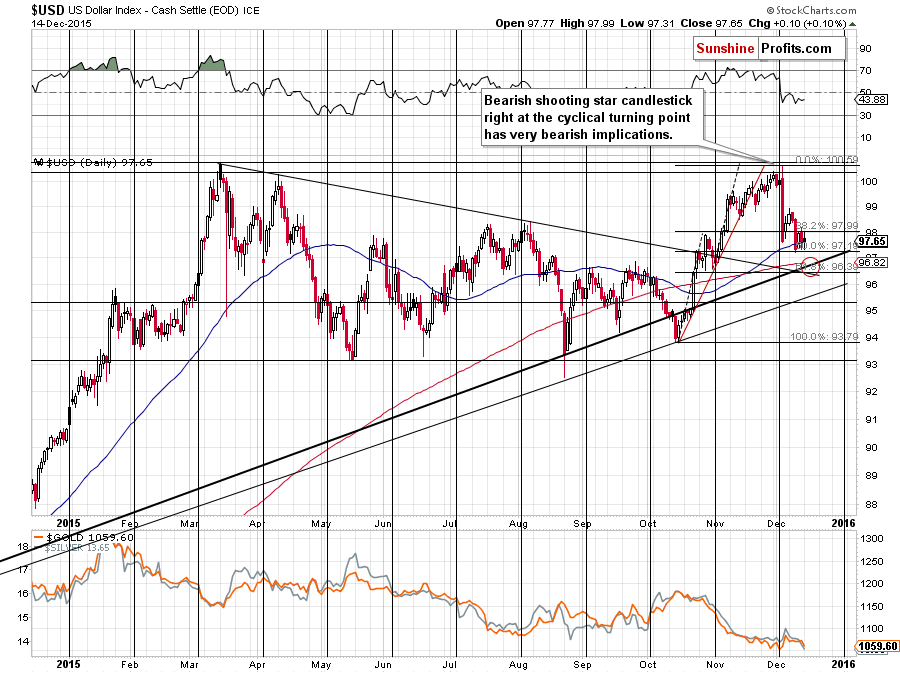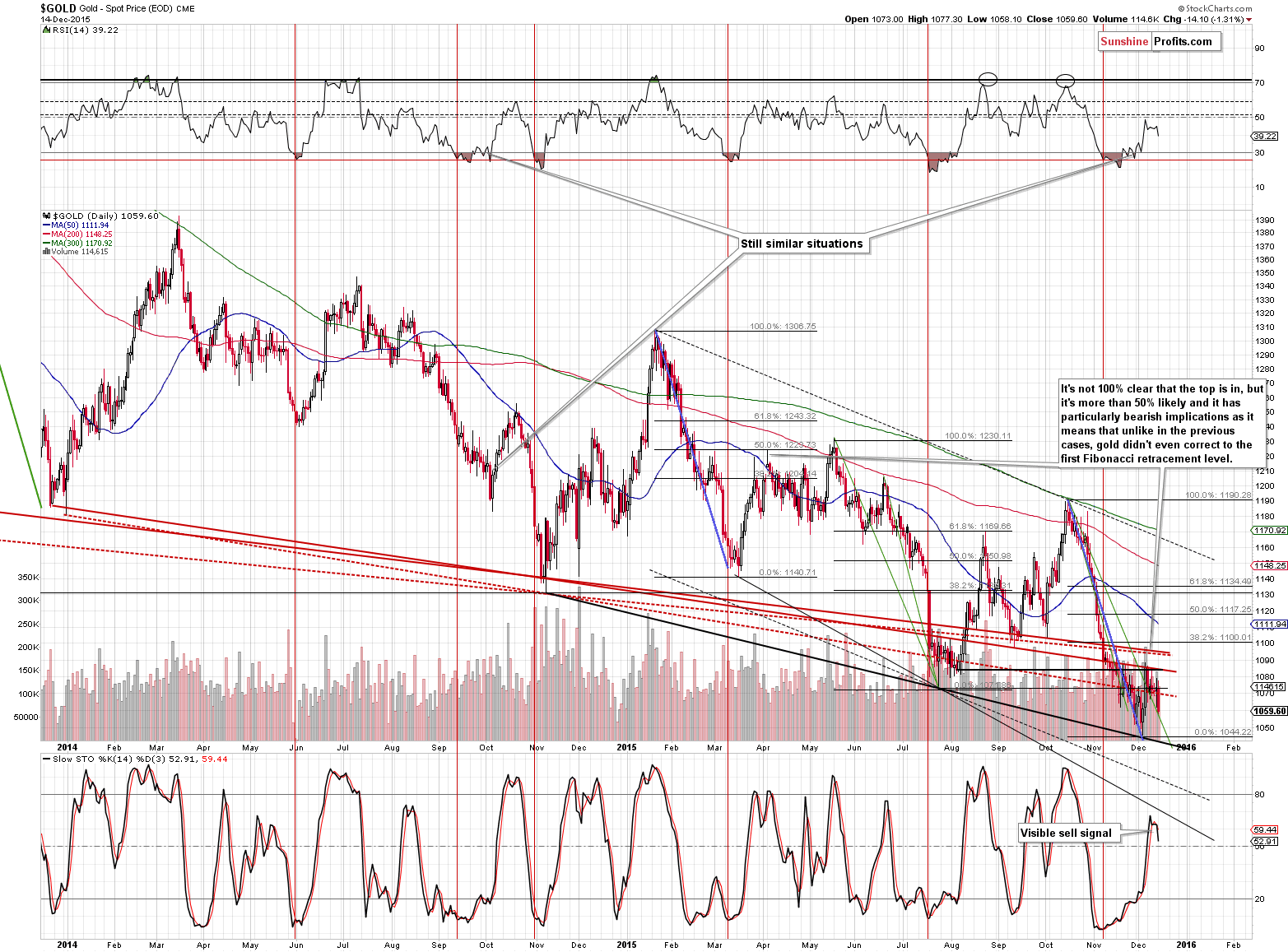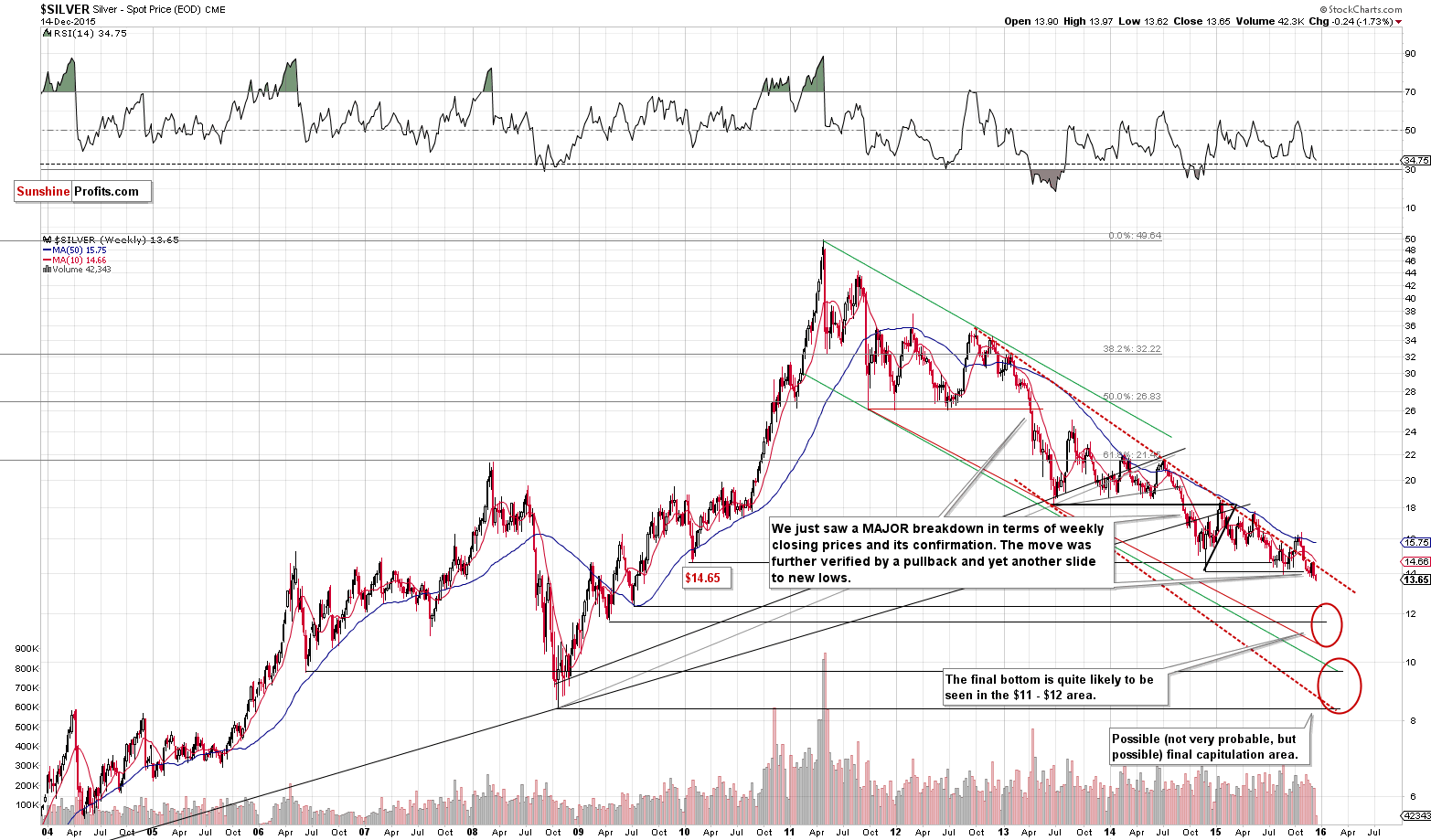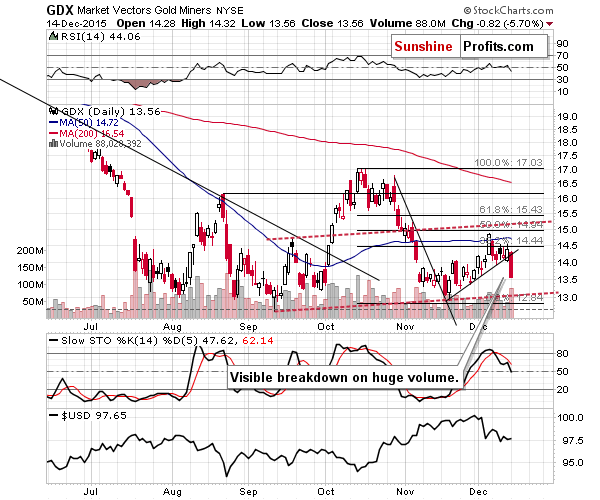Briefly: In our opinion, short (half) speculative positions in gold, silver and mining stocks are justified from the risk/reward point of view.
Despite numerous bullish signals seen in the previous days, metals and miners declined yesterday – what changed?
In short, based on yesterday’s session, almost everything changed – at least as far as the short-term outlook is concerned. Let’s jump right into the charts (charts courtesy of http://stockcharts.com).

Let’s start with the USD Index. Not much changed yesterday despite an intra-day decline. The USD Index didn’t move well below the 97 level, but gold’s intra-day reactions to intra-day moves in USD have bearish implications for the former. Gold didn’t manage to rally when the USD declined and it moved visibly lower when the USD moved back up. Gold “wants” to respond to bearish signals or at least that’s what we can say based on yesterday’s price performance and what we saw in the past few trading days.

From the short-term point of view, we see that gold was trading sideways after a sharp rally and ultimately declined yesterday even though there were no meaningful bearish triggers (for instance in the form of a rising USD Index). The volume that accompanied the decline was not huge, but the size of the move was significant and that alone – in light of the lack of action in the USD – makes the short-term picture bearish.
Gold didn’t move even to the 38.2% Fibonacci retracement, while the analogy suggested a move to the 50% Fibonacci retracement. This could mean that either the rally is not over or that the gold market is currently so weak that it didn’t even manage to rally as far. The indicators can help us decide which is the case right now. The sell signal from the Stochastic indicator is now visible and so is the move lower in the RSI indicator. Back in October 2014 this meant that the rally was already over – which would imply that the gold market is weak at this time.
Before moving on to the silver market, please note that gold often moves in a zigzag fashion and the first part of the decline is equal or very similar to the second part. If the corrective upswing is indeed over and gold is likely to decline by as much (percentagewise) as it did before the upswing, then we might see it decline to $960 or so before the next wave down is over. Would this be the final bottom? It’s possible, but it’s not certain – a lot depends on the number of confirmations that we see when gold moves that low.

Silver moved 24 cents lower yesterday and that was another visible move lower in silver after its recent breakdown. The breakdown is becoming more and more believable. Still, let’s keep in mind that silver is known for its sudden and sharp turnarounds. Moreover, let’s keep in mind what happened before the previous announcement from the Fed – silver soared right before the announcement (at the end of October) and it declined only after that.
While the outlook for silver deteriorated, it’s still possible that we’ll see a sharp rally either today or tomorrow (please note what happened in early July or in late October – the intra-day move).
Yesterday we wrote the following:
It’s likely the case that silver was heavily influenced by the decline in the general stock market (just as the crude oil market was; by the way, in today’s Oil Trading Alert we are taking big profits from our recent short position off the table). Just as crude oil is quite likely to correct from here after reaching an important support level (and our target), the same thing could happen to silver.
Both stocks and crude oil turned around before the end of the session and ended the session higher – but not silver. Just like gold, silver is very weak given what’s happening in the related markets.

From the long-term perspective, we see more confirmations of the breakdown. The breakdown was confirmed by the following: several weekly closes below the previous weekly low; a pullback to the previous lows, the declining red resistance line, and (almost) to the 10-week moving average; the continuation of the decline.
The above makes a slide to at least $12 - $12.50 or so (2009 lows) quite possible in the coming days or weeks.

The situation in mining stocks and its implications changed the most. Until yesterday’s session we saw miners as a part of the precious metals market that held strongly despite the turbulence in both gold and main stock indices. There was positive action in the price-volume link as well, not to mention the invalidation of the previous small breakdown below the rising support line.
Yesterday all of the above was invalidated. Miners underperformed gold and – especially – the general stock market, they declined on huge volume and they broke below the rising short-term support line. Since the volume was huge, we already view the breakdown as confirmed.
On a side note, our long-term subscribers are well aware of this, but since quite a lot new subscribers joined us recently, we’d like to briefly discuss the following issue: does the mentioned move lower (despite a combination of bullish factors in previous days) mean that the techniques that we used don’t work anymore or that our approach was incorrect? Not really. There are no 100% sure situations in trading and one can be correct 80% of the time at most, because at times markets simply do what is unlikely – that’s an inherent part of trading in general. There were many occasions when the techniques that we used proved very useful and very profitable. If our approach was different, then, perhaps, we would have chosen not to bet on the corrective upswing, we would have not participated in this trade, but we would have also missed the profits from the long trade that we entered on July 27 (we saw similar reasons for entering both positions on both occasions).
Summing up, the situation in the precious metals market and the outlook deteriorated substantially based on yesterday’s session. Whenever something is likely to happen in a given market but exactly the opposite happens, we have a strong signal that the market will move in this opposite direction (one of the examples of this rule is an invalidation of a breakout or a breakdown). Based on what happened yesterday and how the market is performing today, we think that we could still see a move higher when the USD Index declines (if it declines), but that this move higher in PMs would be small and would not be the move that we would like to focus on. Instead, based on new short-term bearish signals and due to the looming announcement from the Fed (we expect the Fed to increase rates on Wednesday) we think that small short positions in gold, silver and mining stocks are now justified from the risk to reward perspective. We will most likely adjust this position in the following hours or days (likely doubling it when we see additional bearish confirmations, but it’s too early to do so now).
The precious metals market has shown weakness this week and the next downswing is likely to be significant so the initial target prices are relatively low.
As always, we will keep you – our subscribers – updated.
To summarize:
Trading capital (our opinion): Short positions (half) in gold, silver and mining stocks are justified from the risk/reward perspective with the following stop-loss orders and initial target price levels:
- Gold: initial target price: $973; stop-loss: $1,107, initial target price for the DGLD ETN: $117.70; stop-loss for the DGLD ETN $81.84
- Silver: initial target price: $12.13; stop-loss: $14.37, initial target price for the DSLV ETN: $101.84; stop-loss for DSLV ETN $64.26
- Mining stocks (price levels for the GDX ETF): initial target price: $10.23; stop-loss: $15.47, initial target price for the DUST ETF: $31.90; stop-loss for the DUST ETF $10.61
In case one wants to bet on junior mining stocks' prices (we do not suggest doing so – we think senior mining stocks are more predictable in the case of short-term trades – if one wants to do it anyway, we provide the details), here are the stop-loss details and initial target prices:
- GDXJ ETF: initial target price: $15.23; stop-loss: $21.13
- JDST ETF: initial target price: $52.99; stop-loss: $21.59
Long-term capital (our opinion): No positions
Insurance capital (our opinion): Full position
Plus, you might want to read why our stop-loss orders are usually relatively far from the current price.
Please note that a full position doesn’t mean using all of the capital for a given trade. You will find details on our thoughts on gold portfolio structuring in the Key Insights section on our website.
As a reminder – “initial target price” means exactly that – an “initial” one, it’s not a price level at which we suggest closing positions. If this becomes the case (like it did in the previous trade) we will refer to these levels as levels of exit orders (exactly as we’ve done previously). Stop-loss levels, however, are naturally not “initial”, but something that, in our opinion, might be entered as an order.
Since it is impossible to synchronize target prices and stop-loss levels for all the ETFs and ETNs with the main markets that we provide these levels for (gold, silver and mining stocks – the GDX ETF), the stop-loss levels and target prices for other ETNs and ETF (among other: UGLD, DGLD, USLV, DSLV, NUGT, DUST, JNUG, JDST) are provided as supplementary, and not as “final”. This means that if a stop-loss or a target level is reached for any of the “additional instruments” (DGLD for instance), but not for the “main instrument” (gold in this case), we will view positions in both gold and DGLD as still open and the stop-loss for DGLD would have to be moved lower. On the other hand, if gold moves to a stop-loss level but DGLD doesn’t, then we will view both positions (in gold and DGLD) as closed. In other words, since it’s not possible to be 100% certain that each related instrument moves to a given level when the underlying instrument does, we can’t provide levels that would be binding. The levels that we do provide are our best estimate of the levels that will correspond to the levels in the underlying assets, but it will be the underlying assets that one will need to focus on regarding the sings pointing to closing a given position or keeping it open. We might adjust the levels in the “additional instruments” without adjusting the levels in the “main instruments”, which will simply mean that we have improved our estimation of these levels, not that we changed our outlook on the markets. We are already working on a tool that would update these levels on a daily basis for the most popular ETFs, ETNs and individual mining stocks.
Our preferred ways to invest in and to trade gold along with the reasoning can be found in the how to buy gold section. Additionally, our preferred ETFs and ETNs can be found in our Gold & Silver ETF Ranking.
As always, we'll keep you - our subscribers - updated should our views on the market change. We will continue to send out Gold & Silver Trading Alerts on each trading day and we will send additional Alerts whenever appropriate.
The trading position presented above is the netted version of positions based on subjective signals (opinion) from your Editor, and the Tools and Indicators.
As a reminder, Gold & Silver Trading Alerts are posted before or on each trading day (we usually post them before the opening bell, but we don't promise doing that each day). If there's anything urgent, we will send you an additional small alert before posting the main one.
=====
Latest Free Trading Alerts:
The U.S. House of Representatives approved the Fed Oversight Reform and Modernization (FORM) Act of 2015. What does it imply for the Fed’s independence and the gold market?
=====
Hand-picked precious-metals-related links:
Gold to Breach $1,000 as Fed Lifts Rates in '16, SocGen Says
=====
In other news:
Here's Everything That Could Go Wrong in 2016
Expect at least two Fed rate hikes in 2016: CFO survey
Wall St. expects three more rate hikes in '16: Survey
=====
Thank you.
Sincerely,
Przemyslaw Radomski, CFA
Founder, Editor-in-chief
Gold & Silver Trading Alerts
Forex Trading Alerts
Oil Investment Updates
Oil Trading Alerts



